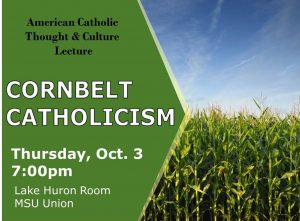49 Abbot Rd
East Lansing, MI 48824
USA

“Cornbelt Catholicism: Migration, Work, and Faith in Rural and Small-Town America and the Future
of American Religion”
Until very recently, the Midwestern United States has been mostly ignored by scholars of American
religion. The Midwest has largely been considered a “fly-over zone,” a flat and mostly
inconsequential place when compared to the coasts. For their part, Catholic Studies scholars have
perpetuated this bias in their research and teaching, focusing their efforts on urban northern and
eastern parishes. Indeed, Catholicism in the urban north and northeast has much to say about lived
Catholicism in America, but it tells just part of the story.
When we turn our gaze to the long- overlooked Midwest, and to the Cornbelt region more
particularly, we can better understand the significance of this region for the ever-growing numbers of
migrants and refugees who fill the pews and workplaces across small town America. It is these
migrants who harvest the crops, milk the cows, candle the eggs, and slaughter and package the meat
that is sent across the U.S. and beyond. Latinas/x/os’ Chin Burmese, and African refugees’ labor is
literally feeding much of the world.
This lecture will draw on six years’ worth of ethnographic fieldwork, and will introduce the
reader to stories white ethnics, Latinas/x/os, and African refugees have shared with me about the
work of religion in their lives in rural America; offer ethnographically focused snapshots of
migration experiences, Catholic parish outreach, activist priests, and migrants’ work at farm fields
and meatpacking plants; make a case for the Cornbelt as ground zero for understanding current
as well as future trends in migration, work and faith in America. U.S. states like Iowa, Illinois,
Kansas and Nebraska continue to draw large numbers of migrants and refugees because of the
relatively low cost of living and the availability of steady work in the agricultural and protein
industry. A study of white ethnics, Latinos/as, and other more recent arrivals like the Congolese and
Sudanese in the Cornbelt also helps us to better understand the chasm that exists between brown,
black, and white America. Communities that embrace change and accept new arrivals to their communities are the ones that flourish and that havea future. Their parishes, housing markets, downtowns, and storefronts are bustling places, symbols of
opportunity and hope for a multi-ethnic and religious America.
